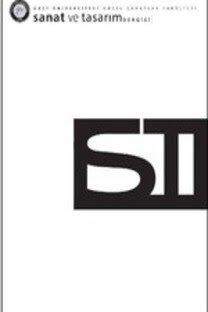Kuramsal ve Uygulamalı İşleyimsel Tasarım Eğitimi Sürecinin Dizgesel İşleyiş Ölçütleri Işığında Çözümlenmesi Üzerine Bir Yöntemsel Yaklaşım Önerisi
Bu çalışmada, İşleyimsel (Industrial) Tasarım özelinde tüm tasarım etkinliklerine uyarlanabilecek olan bir eğitim süreci çözümlemesi, ilgili alanyazından alıntılanan bulgu ve çıkarımların birer bileşen haline getirilmeleri ve aralarındaki etkileşim akışının tanımlanması yoluyla edinilen veriler ışığında anlamlı önermelerin ortaya koyulması yaklaşımı üzerinden yürütülmüştür. Çalışmanın özgün bulguları, tasarım süreci ile eğitime ilişkin yöntemsel aşamaların birbirlerinden bağımsız olarak
ele alındıklarını göstermiştir. Bu durum, sezgisel / bütüncül kavrayışa dayandırılan tasarım eğitimi yaklaşımlarının genel anlamda çözümlemeci bir anlayışa eğilimli olarak yürütülmediğini ortaya koyar. Araştırma sonuçları, çözümleme sürecinin alt unsurları olan ayrıştırma ve bireştirme etkinliklerinin
dizgesel işleyişe ilişkin ilke ve ölçütler doğrultusunda yürütülmesi yoluyla ve sezgisel kavrayışa yönelik unsurların bu süreçte birer bileşen olarak ele alınması koşuluyla, kuramsal ve uygulamalı tasarım eğitimi süreçlerinin içerikleri ve sınırları üzerine özelleşmiş tanımlar yapılabileceğini göstermektedir.
Anahtar Kelimeler:
Tasarım Süreci, Dizgisel Çözümleme, Tasarım Eğitimi, İşleyimsel Tasarım, Sezgisel Düşünme
___
- Álvarez, A. ve Ritchey, T., (2015). “Applications of general morphological analysis”. Acta Morphologica Generalis, 4(1).
- Bequette, J.W. ve Bequette, M.B. (2012). “A place for art and design education in the STEM conversation”, Art Education, 65(2), s. 40-47.
- Belaziz, M., Bouras, A. ve Brun, J.M. (2000). “Morphological analysis for product design”, Computer-Aided Design, 32(5-6), s. 377-388.
- Butt, M., Sharunova, A., Storga, M., Khan, Y.I. ve Qureshi, A.J., (2018). “Transdisciplinary engineering design education- Ontology for a generic product design process”, Procedia CIRP, 70, s. 338-343.
- Cropley, D. ve Cropley, A. (2010). “Recognizing and fostering creativity in technological design education”, International Journal of Technology and Design Education, 20(3), s.345-358.
- Cropley, A. J., ve Cropley, D. H. (2009). Fostering creativity: A diagnostic approach for higher education and organizations, Cresskill, NJ: Hampton Press.
- Dorst, K. ve Reymen, I.M.M.J. (2004). “Levels of expertise in design education”, DS 33: E&PDE 2004, the 7th International Conference on Engineering and Product Design Education, Delft, 02.-03.09. 2004.
- Dreyfus H.L. (2003a). “From Socrates to Artificial Intelligence: The Limits of Rule-Based Rationality”, Unpublished lecture notes of the first 2003 Spinoza Lecture at the University of Amsterdam.
- Dreyfus H.L. (2003b). “Can there be a better source of meaning than everyday practices?”, Unpublished lecture notes of the second 2003 Spinoza Lecture at the University of Amsterdam.
- Green, P.E., Carroll, J.D. ve Goldberg, S.M. (1981). “A general approach to product design optimization via conjoint analysis”, Journal of Marketing, 45(3), s.17-37.
- Hatchuel, A. (2006). “A framework for analyzing design. Adornment and wit in industrialdesign”, In.Henriksen, D., Mishra, P. ve Fisser, P. (2016). “Infusing creativity and technology in 21st century education- A systemic view for change”, Educational Technology & Society, 19(3), s. 27-37.
- Hill, A.M. (1998). “Problem solving in real-life contexts - An alternative for design in technology education”, International journal of technology and design education, 8(3), s. 203-220.
- Irbite, A. ve Strode, A. (2016). “Design thinking models in design research and education”, In Proceedings of the International Scientific Conference. 4 (488), 500.
- Ison, R.L. (2008). Systems thinking and practice for action research. In: Reason, Peter W. and Bradbury, Hilary eds. The Sage Handbook of Action Research Participative Inquiry and Practice (2. baskı). London, UK: Sage Publications, s. 139-158.
- Lawson, B. (1990). How Designers Think. Butterworth Architecture, London. Massachusetts Department of Education (2006). “Massachusetts Science and Technology / Engineering Curriculum Framework”, Malden, MA: MDOE.
- Norman, E., Riley, J., Urry, S. ve Whittaker, M. (1990). Advanced Design and Technology. Longman, Essex.
- Pimmler, T.U. ve Eppinger, S.D. (1994). Integration analysis of product decompositions.
- Pourdehnad, J., Wexler, E.R. ve Wilson, D.V. (2011). “Integrating systems thinking and design thinking”, The Systems Thinker, 22(9), 2-6.
- Reigeluth, C.M. (1994). Introduction: An imperative for system change. Systemic Change in Education. Englewood Cliffs, NJ: Educational Technology Publications.
- Reigeluth, C.M. ve Avers, D. (1997). Educational Technologists, Chameleons, and Systemic Thinking. Educational media and technology yearbook, 22, s. 132-37.
- Savransky, S. D. (2000). Engineering of creativity. Boca Raton, FL: CRC Press.
- Sternberg, R. J., Kaufman, J. C., ve Pretz, J. E. (2002). The creativity conundrum: A propulsion model of kinds of creative contributions. New York: Psychology Press. Sy, M. ve Mascle, C. (2011). “Product design analysis based on life cycle features”, Journal of Engineering Design, 22(6), s.387-406.
- Vande Zande, R. (2007). “Design education as community outreach and interdisciplinary study”, Journal for Learning through the Arts 3(1). Irvine, CA: University of California.
- Vande Zande, R. (2010). “Teaching design education for cultural, pedagogical, and economic aims”, Studies in Art Education, 51(3), s. 248-261.
- Zwicky, F. (1969). Discovery, Invention, Research - Through the Morphological Approach, Toronto: The Macmillian Company.
- ISSN: 1308-2264
- Yayın Aralığı: Yılda 2 Sayı
- Başlangıç: 2015
- Yayıncı: Ankara Hacı Bayram Veli Üniversitesi
Sayıdaki Diğer Makaleler
Cecily Brown’ın Eserlerinde Resimlerarasılık Süreci ve Yeni Dışavurumcu Tavır Üzerine Bir İnceleme
Magnesia Skylla Başlığı’nda Kullanılan Farklı Bir Kalıp Alma Yöntemi
İsmail Emre KAVUT, Burçin SAVAŞ
Yaşamı İnkâr Etme İstencinin Tek Karşı Gücü Olarak Sanat
Konya Karatay Belediyesi Tarafından Yürütülen Proje ve Bu Kapsamda Üretilen Örgü Sepetler
Pars (Leopar) Postunun Mitolojik Olarak İncelenmesi ve Anadolu Dokumalarında Kullanımı
Fotoğraf, Bellek ve Gerçekliğin Temsili Üçgeninde Gerhard Richter’in ‘Foto Resim’leri
İç Mekân Tasarımında Özgünlük ve Konsept: Özgün ve Özgün Olmayan Mekânların Karşılaştırılması*
Kültür Aktarımında Bireysel Sosyal Sorumluluk ve Dilin Doğru Kullanımı: Bir Afiş Tasarımı
